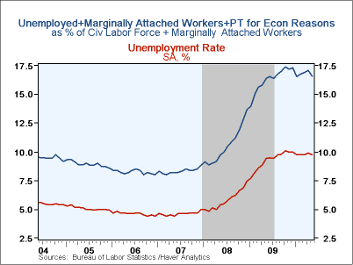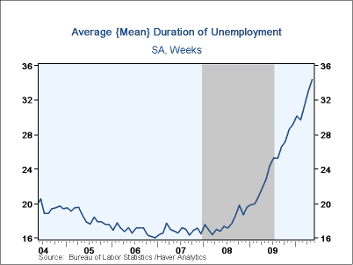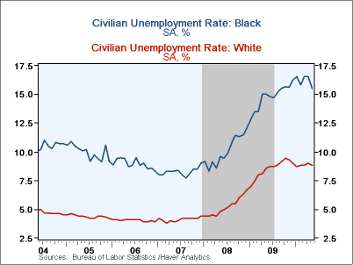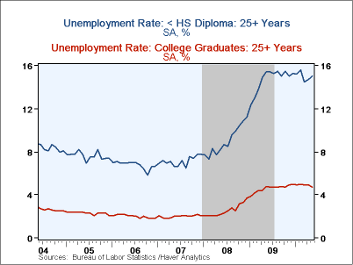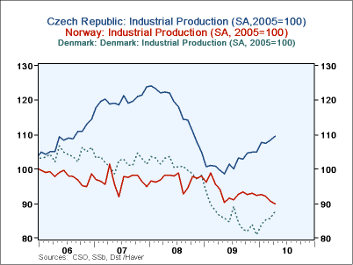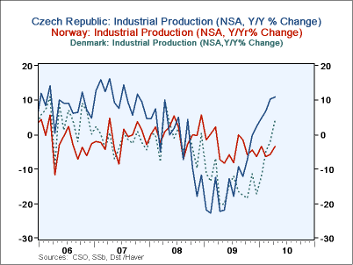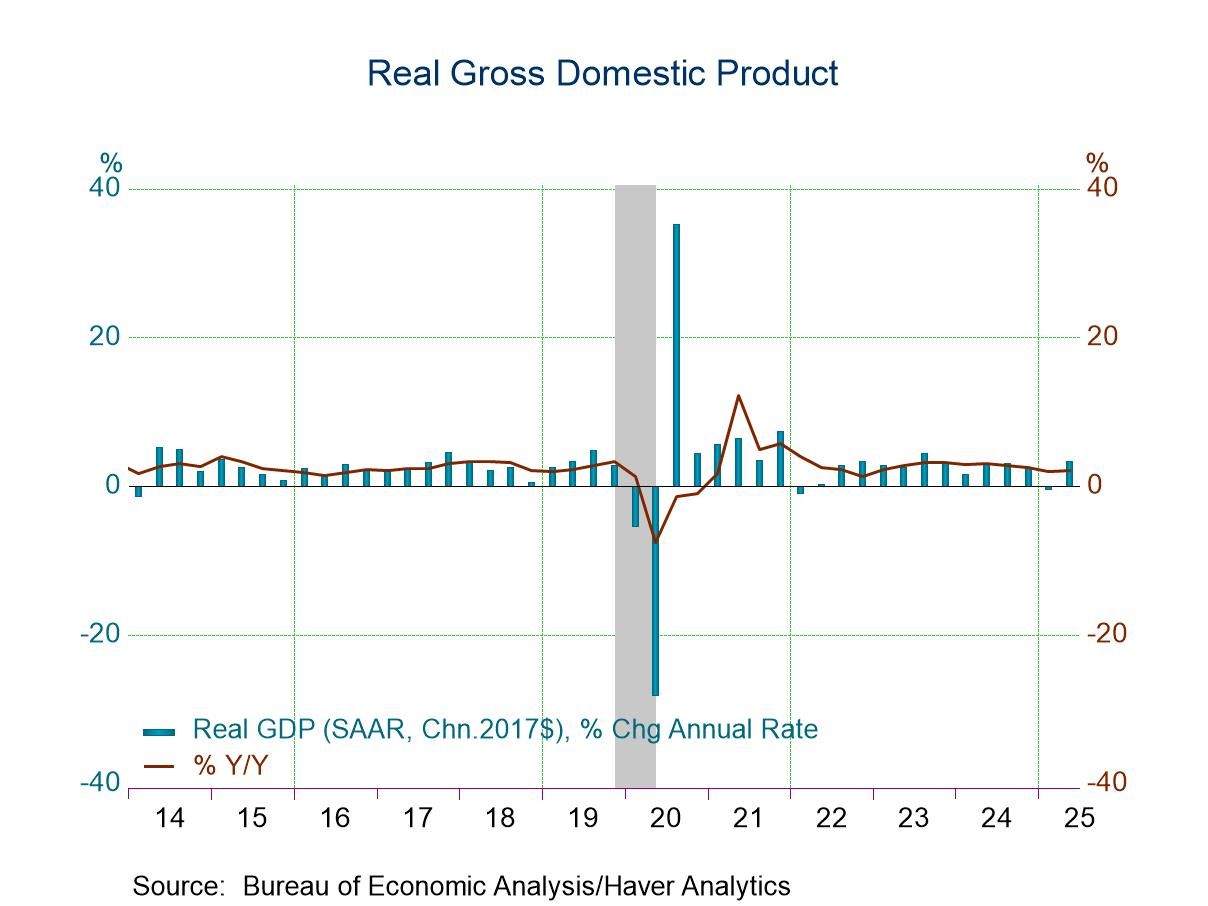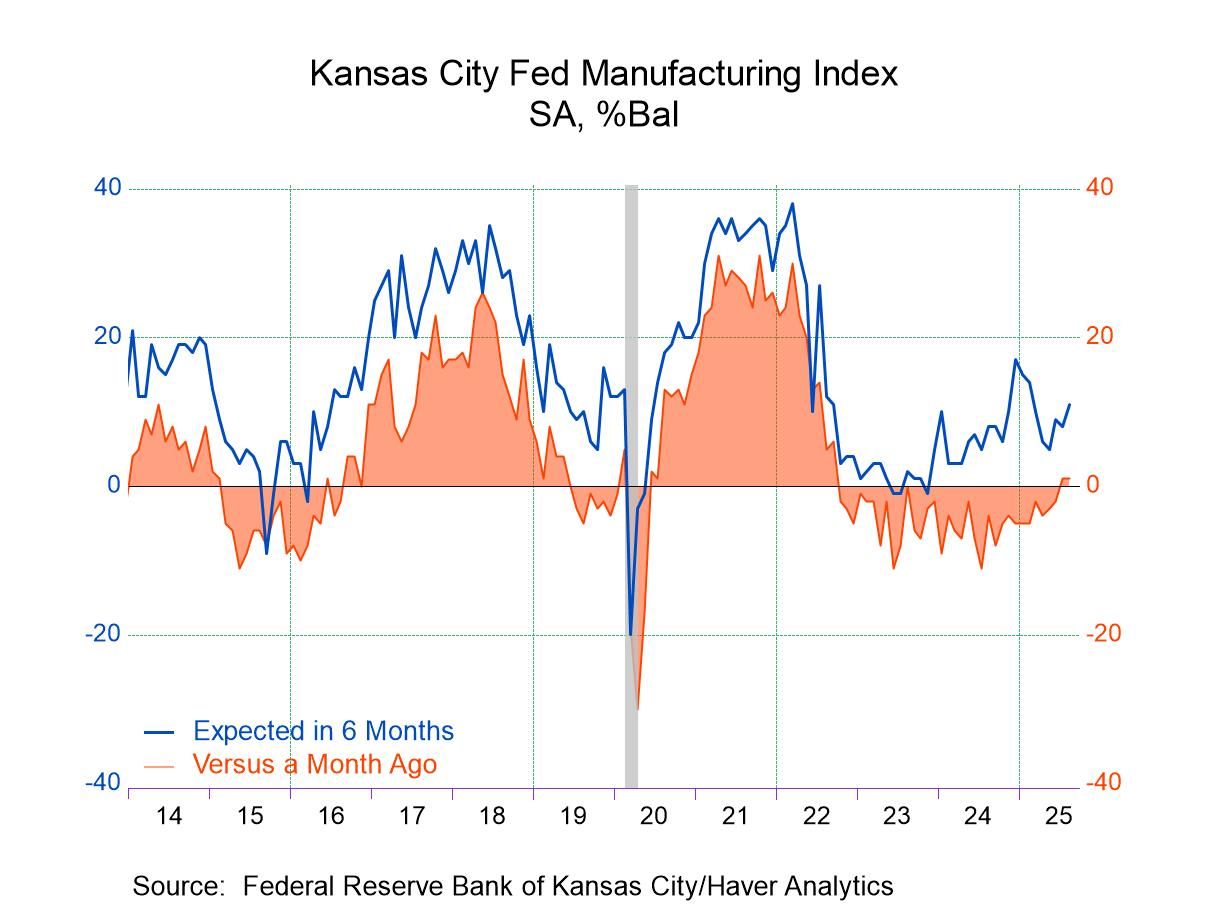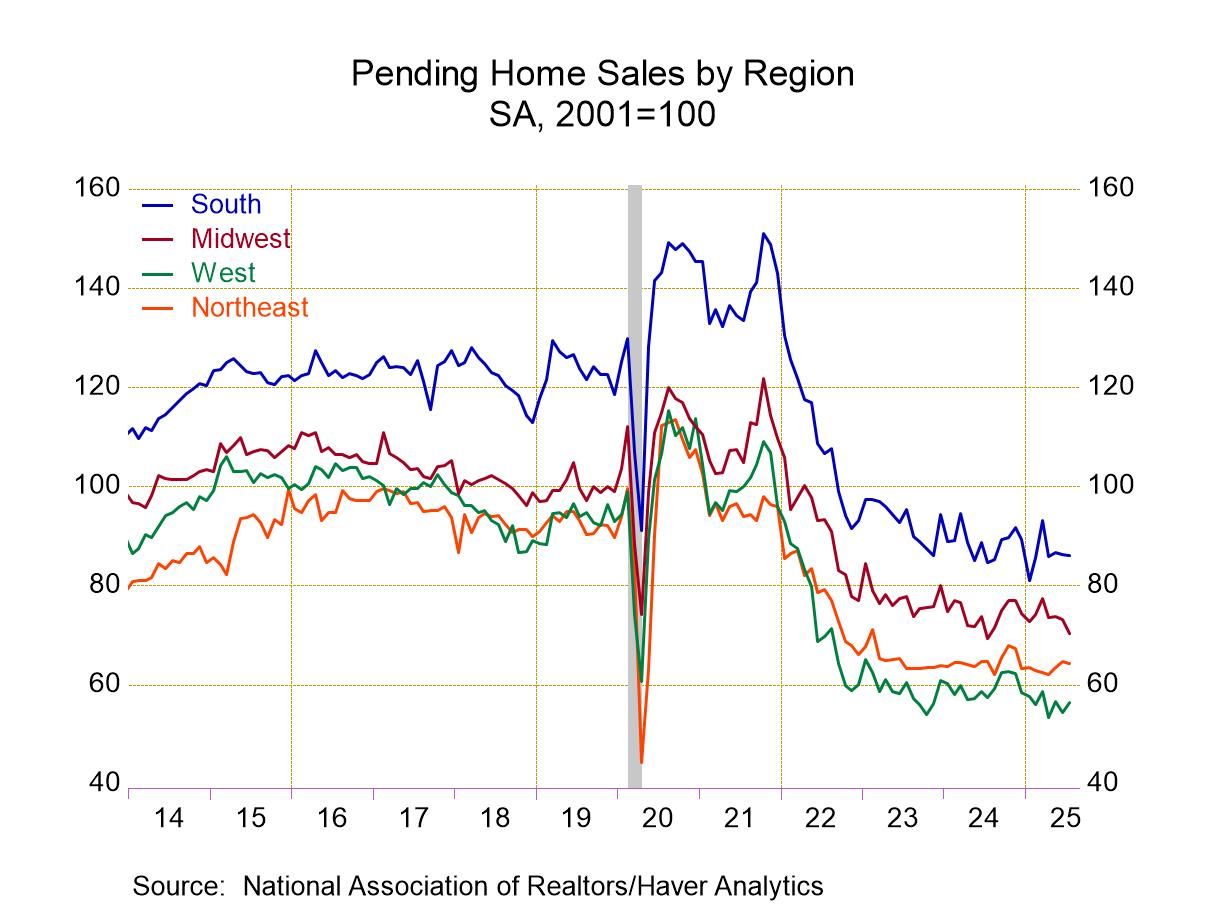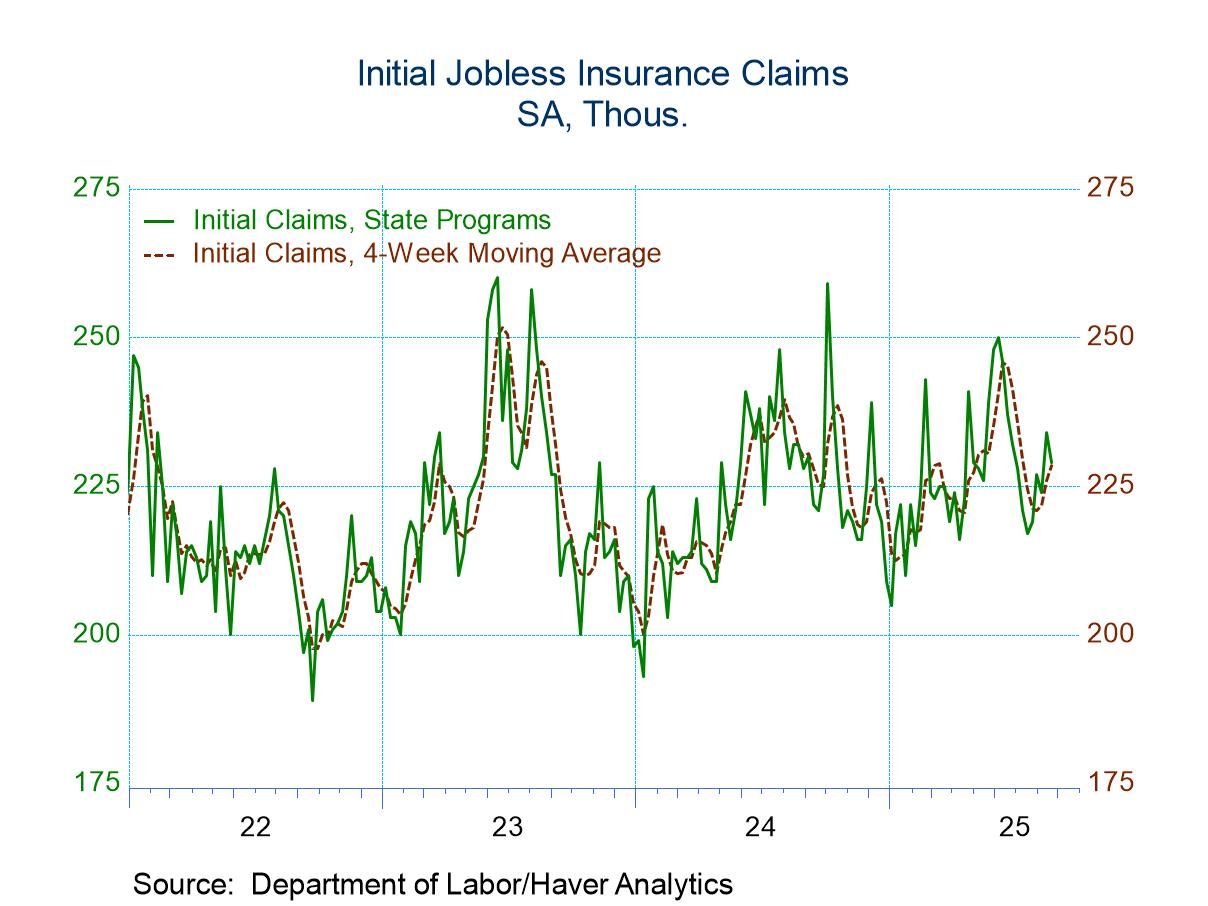 Global| Jun 07 2010
Global| Jun 07 2010U.S. Unemployment Situation Varies Greatly For Many Reasons
by:Tom Moeller
|in:Economy in Brief
Summary
Contained in Friday's employment report, which showed that the total civilian unemployment rate fell, was an increase in a broader measure which includes marginally attached workers and those working part-time for economic reasons. [...]
Contained in Friday's employment report, which showed that the total civilian unemployment rate fell, was an increase in a broader measure which includes marginally attached workers and those working part-time for economic reasons. This series slipped to 16.6% from the 4Q '09 high of 17.3%, but the high levels suggest digging deeper into the report for a fuller appreciation of the jobs picture, and it's not good.
To start, the average duration of unemployment rose to a record high of 34.4 weeks, up ten weeks from last year's average. The increase reflected an increase in the percentage of those unemployed for 27 weeks or more rising to 46.0% from 31.1% last year.
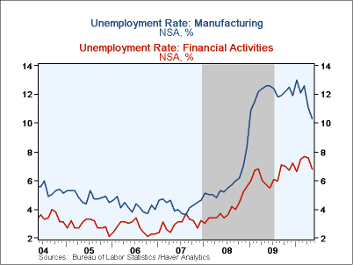 By industry, the unemployment rate for
construction stood at 20.1% versus its high of 27.1% in February. These
figures are not seasonally adjusted (NSA) so an upturn during winter
was followed by a normal drop come spring. But the y/y figure compares
to 19.2% one year ago and a range of 5%-to-8% before the recession
began. In manufacturing, unemployment stood at 10.3% versus 12.1% for
all of last year and more than double the 2007 average. In
transportation, the rate also was double-digit but in the financial
industry it stood at 6.8% versus 3.0% in 2007. Unemployment in
government sector lagged all these rates.
By industry, the unemployment rate for
construction stood at 20.1% versus its high of 27.1% in February. These
figures are not seasonally adjusted (NSA) so an upturn during winter
was followed by a normal drop come spring. But the y/y figure compares
to 19.2% one year ago and a range of 5%-to-8% before the recession
began. In manufacturing, unemployment stood at 10.3% versus 12.1% for
all of last year and more than double the 2007 average. In
transportation, the rate also was double-digit but in the financial
industry it stood at 6.8% versus 3.0% in 2007. Unemployment in
government sector lagged all these rates.
By age, the unemployment rate for teenagers stood just under its record high last month at 26.4%. For teenage males it was 28.1%. For those aged 25 or over, the rate also was near its record at 8.4% which was more than double the 2007 average. For adult men, the unemployment picture was more discouraging. Overall the rate of 10.5% compared to 8.8% for women. For men over-25 the rate was 9.1% versus 7.6% for women. For both, these rates are double the 2007 low.
By race the unemployment figures indicate an even sharper divergence. The white unemployment rate of 8.8% compared to 15.5% for African Americans. For teenage blacks the rate jumps to an even higher 38.4%; 39.7% for women compared to 25.0% during all of 2007. For whites the unemployment rate overall was 8.5% last month, double the '07 rate. For teenage whites the rates also was a healthy 25.1% and was 26.2% for males.
Education pays. For adults with less than a high school diploma the unemployment rate totaled 13.6% last month compared to 10.3% for those graduates but no college. Having attended some college helped and lowered unemployment further but graduating dropped the unemployment rate to 4.4%. The unemployment rate for adult whites with a BA degree or higher stood at 4.1% while for Asians it was 4.8% last month. For Hispanics or Latinos the rate was 5.9% and for blacks the rate totaled 7.2%. All of these rates are roughly double the 2007 average.
The figures referenced above are available in Haver's USECON database. Additional detail can be found in the LABOR and in the EMPL databases.
by Robert Brusca June 7, 2010
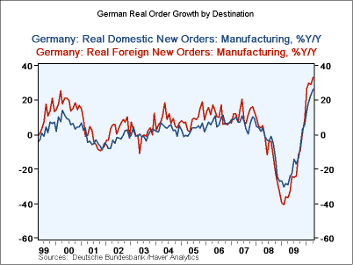 German orders surged in April rising by 2.8% on the heels of a 5.1%
gain in March. As a result the three month growth rate of orders is up
to 36.7% (saar). Foreign orders are roaring at a 43.3% annual rate over
three months. Domestic orders are up at a nearly 30% annual rate.
Still, overall German orders are down nearly 17% from their cyclical
peak with foreign orders down by 20% and domestic orders off by13%. In
the midst of all the cheering, it's good remember where we stand.
German orders surged in April rising by 2.8% on the heels of a 5.1%
gain in March. As a result the three month growth rate of orders is up
to 36.7% (saar). Foreign orders are roaring at a 43.3% annual rate over
three months. Domestic orders are up at a nearly 30% annual rate.
Still, overall German orders are down nearly 17% from their cyclical
peak with foreign orders down by 20% and domestic orders off by13%. In
the midst of all the cheering, it's good remember where we stand.
At the G-20 meeting US Treasury Secretary Tim Geithner argued that Europeans surplus counties had to commit to growth. German orders seem to be on the right track for that. But Angela Merkel is looking to restore budget 'balance' already while the rest of the G-20 still seems to be the mode of arguing that it is too soon to take away the special sauce of cyclical stimulus. But German is nonetheless pursing a policy that says, hold the pickles, hold the lettuce. Time will tell if this will upset us.
Certainly Germany points up a dilemma in global policy coordination.
As Europe's largest economy Germany needs to set an example and make the right contribution. Merkel seems to think that means restoring fiscal order as soon as possible. But, arguably, one of the main things that caused this mess - the original financial crisis -- was the gaping wide US balance of payments deficits. They caused money to pour into the US and seek out investments that foreign investors had no special insight for. So now the US is going to grow strongly but other countries are going to slam on the brakes and the US current account deficit is going to balloon again. So why is that good? If Germany won't be part of the solution, it will become part of the problem. Its policy approach is very ethnocentric and shows why the euro will never be able to serve a role as a reserve unit to rival the dollar. Policy in Europe has no international dimension.
Germany has a very high export-to-GDP ratio. It is exploiting the global economy and its growth for its worth. Germany is not contributing much in the way of demand to the world economy although it is a relatively rich nation. And now with the euro having crashed and burned German competitiveness has been fully augmented, putting it in a position to be able to depend on better growth. So Merkel feels less constrained about tackling her budget deficit that ahs been exacerbated by Germany's pledge to assist Greece. So is Merkel being virtuous or villainous?
In this recovery period Germany has been consistently posting surprisingly strong economic figures. That stopped a month or so ago when some of the leading indicators of confidence and expectations began to waffle in the wake of the European troubles. Up until that time German growth estimates had been marked higher. Now is a curious time for economists as the German orders are surprisingly strong and the weak euro is surly going to boost growth but at a time when there is worry about backsliding in the rest of Europe because of the fiscal austerity planes being adopted throughout the region.
All this is curious. It is as though Merkel does not want to be left behind as Portugal, Spain and Greece set their teeth for some austerity. But Germany does not need as much as the other regions. Merkel may be dealing with domestic issues and perceptions as much as anything in her pursuit of fiscal redress. Germany may face enhanced growth prospects because of the weak euro, but its domestic economy is still struggling and its unemployment is high. Yet because of its social safety net those are not political impediments back home. Germans like austerity.
Unlike a lot of other economists I am not so afraid of a Euro-slowdown and it has nothing to do wit the numbers. By the numbers the US fiscal stimulus program should have been a smashing success but it was not because it was crafted for ideological goals by an administration that underestimated the true severity of recession but over sold the risk to get a large spending program it could then misallocate based on its underestimate of need. In Europe we see austerity being developed in countries that don't really have the backbone for it. So while there will be some success I thing austerity is one of the things politicians do the worst. So let's not oversell its impact...except maybe in Germany. Germany is one place where austerity means something. Germany has a hard money culture because of some real economy mistakes of the opposite nature. And just as, no one is more of tyrant about not smoking than a former a smoker, or about not drinking than a former drinker, no one is more cocksure about austerity than a former monetary abuser. So Germanys tilt to tightness is something not to be ignored.
As a result of all this Europe is caught in a vicious policy vortex and in market cross-currents that are some of the worst that it has ever seen. If there were independent currencies in Europe we would be seeing some real fun. But it's not working that way this time. It think it's too soon to mark down growth forecasts in Europe since the recovery has actually been looking stronger in the recent data and since the lower euro value will give Europe a boost. Germany's tilt toward austerity, if it comes, bears watching. But I don't look for the rest of the region to over do it except maybe Greece which is under a special kind of microscope.
We should remain on the watch not just for policy moves but for how economic data behave. The orders from Germany are stunningly strong for a country in region where US economists have begun to cut growth forecasts. Europe is topsy-turvy and Germany is in the center of it all.
| German Orders and Sales By Sector and Origin | ||||||||
|---|---|---|---|---|---|---|---|---|
| Real and SA | % M/M | % Saar | ||||||
| Apr-10 | Mar-10 | Feb-10 | 3-MO | 6-Mo | 12-Mo | YrAgo | QTR-2-Date | |
| Total Orders | 2.8% | 5.1% | 0.0% | 36.7% | 16.9% | 29.8% | -33.2% | 44.3% |
| Foreign | 2.8% | 4.7% | 1.7% | 43.3% | 19.7% | 33.1% | -36.6% | 46.3% |
| Domestic | 2.9% | 5.6% | -1.7% | 29.9% | 14.0% | 26.1% | -29.1% | 42.1% |
| Real Sector Sales | ||||||||
| MFG/Mining | 1.2% | 3.1% | -0.2% | 17.5% | 8.4% | 13.2% | -23.8% | 20.8% |
| Consumer | -1.9% | 4.7% | -2.1% | 2.2% | 1.1% | -1.7% | -7.3% | 2.6% |
| Cons Durables | 1.2% | -0.8% | -2.4% | -7.6% | -3.9% | 7.7% | -24.1% | -0.7% |
| Cons Non-Durable | -2.3% | 5.5% | -2.2% | 3.4% | 1.7% | -3.1% | -4.0% | 3.2% |
| Captial Gds | 0.4% | 2.4% | 0.5% | 14.3% | 6.9% | 16.8% | -31.0% | 14.0% |
| Intermediate Gds | 3.8% | 3.2% | -0.3% | 29.9% | 14.0% | 19.0% | -23.3% | 40.6% |
| All MFG-Sales | 1.2% | 3.1% | -0.2% | 17.4% | 8.4% | 13.3% | -23.7% | 20.8% |
by Louise Curley June 7, 2010
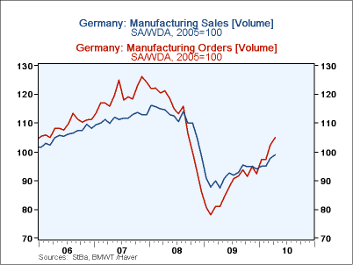 The news
from Europe is not all bad. Data released today show that the
real sector, as opposed to the financial sector, continues to improve
in a number of countries. German Manufacturing Orders and Sales
increased in April, contrary to expectations of a
decline. The volume of new orders rose 2.9 points
to 105.1 (2005=100) in April after a 5.0 point rise in March.
Comparable figures for the volume of sales were a rise of 1.2 points in
April after a 2.9 point rise in March. Sales and new orders
are shown in the first chart. Last week, it was announced
that the registered unemployment rate IN Germany had fallen to
7.7%. It is now five percentage points below November 2009.
The news
from Europe is not all bad. Data released today show that the
real sector, as opposed to the financial sector, continues to improve
in a number of countries. German Manufacturing Orders and Sales
increased in April, contrary to expectations of a
decline. The volume of new orders rose 2.9 points
to 105.1 (2005=100) in April after a 5.0 point rise in March.
Comparable figures for the volume of sales were a rise of 1.2 points in
April after a 2.9 point rise in March. Sales and new orders
are shown in the first chart. Last week, it was announced
that the registered unemployment rate IN Germany had fallen to
7.7%. It is now five percentage points below November 2009.
Other countries releasing data on production today were Norway, Denmark and the Czech Republic. Although Industrial Production continued to decline in Norway in April, the year over year percent of decline has abated. Industrial production in Denmark in April was 4.2% above the year ago figure. This was the first significant positive change since September, 2008. Finally, industrial production in the Czech Republic continues to forge ahead. The index was 109.5 (2005=100) in April, 10.9% above April 2009. The actual indexes of Industrial Production and the year to year changes in the indexes for the three countries are shown in the second and third charts.
| May 10 | Apr 10 | Mar 10 | Feb 10 | Jan 10 | Dec 09 | Nov 09 | Oct 09 | |
|---|---|---|---|---|---|---|---|---|
| INDUSTRIAL PRODUCTION (2005=100) | ||||||||
| Czech Republic | -- | 109.5 | 108.4 | 107.6 | 107.8 | 104.9 | 104.8 | 104.6 |
| Norway | -- | 90.0 | 90.7 | 92.1 | 92.6 | 92.4 | 93.0 | 92.6 |
| Denmark | -- | 87.6 | 85.7 | 85.2 | 83.9 | 81.0 | 93.9 | 82.1 |
| INDUSTRIAL PRODUCTION Y/Y% Change | ||||||||
| Czech Republic | -- | 10.9 | 10.2 | 6.9 | 4.9 | 2.3 | -0.2 | -7.4 |
| Norway | -- | -3.5 | -5.2 | -6.3 | -3.5 | -6.3 | -4.5 | -5.9 |
| Denmark | -- | 4.2 | -2.0 | -4.8 | -12.0 | -17.1 | -11.3 | -18.4 |
| GERMANY | ||||||||
| New Orders Volume (2005=100) | -- | 105.1 | 102.2 | 97.2 | 97.2 | 92.4 | 94.7 | 91.4 |
| Sales Volume (2005=100) | -- | 99.0 | 97.8 | 94.9 | 95.1 | 94.0 | 95.0 | 94.8 |
| Registered Unemployment Rate (%) | 7.7 | 7.8 | 8.0 | 8.1 | 8.1 | 8.1 | 8.2 | 8.2 |
Tom Moeller
AuthorMore in Author Profile »Prior to joining Haver Analytics in 2000, Mr. Moeller worked as the Economist at Chancellor Capital Management from 1985 to 1999. There, he developed comprehensive economic forecasts and interpreted economic data for equity and fixed income portfolio managers. Also at Chancellor, Mr. Moeller worked as an equity analyst and was responsible for researching and rating companies in the economically sensitive automobile and housing industries for investment in Chancellor’s equity portfolio. Prior to joining Chancellor, Mr. Moeller was an Economist at Citibank from 1979 to 1984. He also analyzed pricing behavior in the metals industry for the Council on Wage and Price Stability in Washington, D.C. In 1999, Mr. Moeller received the award for most accurate forecast from the Forecasters' Club of New York. From 1990 to 1992 he was President of the New York Association for Business Economists. Mr. Moeller earned an M.B.A. in Finance from Fordham University, where he graduated in 1987. He holds a Bachelor of Arts in Economics from George Washington University.


